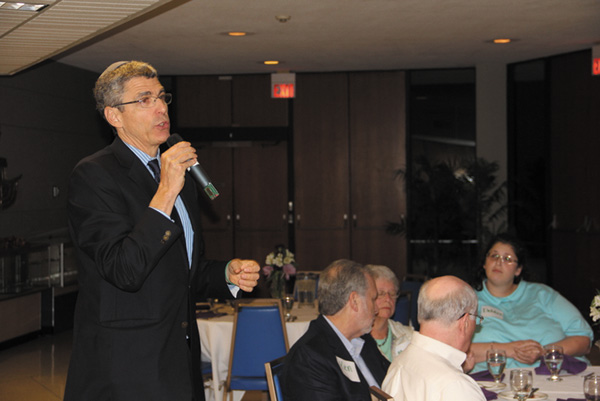On St. Louis visit, URJ President discusses Reform’s future
Published October 31, 2012
Rabbi Rick Jacobs, the recently installed president of the Union for Reform Judaism, is upbeat on the future of the movement he heads. He feels strongly it is diverse and inclusive enough to meet the spiritual needs of a large segment of the Jewish population.
Jacobs, 57, a native of New Rochelle, N.Y. who grew up in Tustin, Calif., was elected in June 2011 to succeed Rabbi Eric Yoffie as URJ president, and was installed in July 2012. He is the rabbi emeritus as Westchester Reform Temple in Scarsdale, N.Y., where he served as senior rabbi for nearly two decades. The URJ represents close to 900 congregations and roughly 1.5 million people, according to its estimates.
Jacobs was in St. Louis recently to participate in the celebration of United Hebrew Congregation’s 175th anniversary. While here, he visited other local congregations and held a number of meetings with lay and professional leaders of Jewish organizations in St. Louis. The Jewish Light caught up with Jacobs during his visit for an interview.
What else do you hope to accomplish during your visit?
The commitment I’m making when traveling is not just to dive in and dive out, but to get a chance to know the community. For example, tonight we are having a meeting with all of our lay leaders of the Reform movement here together. Tomorrow morning, I’m meeting with Federation leadership. At noon, I’m meeting with professional leaders. It’s a chance to really get to know what’s going on in this community…to get a window into a unique and certainly a longstanding Reform Jewish community that’s been through its own wonderful evolution.
The recent Jewish Population Survey in Greater New York indicated fast growth among the Orthodox and Haredi communities but a net loss since the last survey of 40,000 each for the Reform and Conservative Movements. What is your take on those numbers?
New York is unlike any other North American city pretty much in every regard, but particularly around Jewish demography. The centrality of ultra-Orthodox Jewish institutions and the number of Orthodox Jews in New York is unlike anything outside of Jerusalem. So to see that growth among the Orthodox and ultra-Orthodox is not surprising. Where I think we are having some interesting disputes about both the study’s findings and the important takeaways, is that it is critical to define who you count. Do you count the people who are formally members? Do you count the people who participate, whose parents come to the High Holiday services, whose weddings and funerals are conducted by Reform rabbis?
We are trying to pay attention to the demographic studies but not become slaves to their assumptions.
So, are you saying the raw numbers of various studies only tell part of the story?
The recent Pew Study on Religious Affiliation says that one out of five Americans defines themselves as having no religious faith. So for us, we are paying a lot of attention to the fact that one-fifth of North American Jewry is not formally a member of a Reform, Conservative or Orthodox synagogue.
Another thing to consider is that not all members of a synagogue are really engaged. Some of them are quite peripherally connected. So we can have a whole sense of who is ‘with us’ versus who is ‘really with us.’ We cannot assume that just because one is formally a member of a synagogue that you are deeply engaged in Jewish life or vice versa. These are wrong assumptions and I think they are really hurting us in strategizing how we are going to strengthen the movement. We think that Jewish life needs to be strengthened, and that Reform is an important part of it, but we are not all of it.
In St. Louis, the Reform Jewish day school merged with the local Schechter school. Is it farfetched to think that one day the Reform and Conservative movements may converge — or merge?
I don’t think there will be a formal merger. For many Conservative Jews, they may have a hard time walking in, but what we do have now is a wider palette of ritual, ceremony and social justice work.
There are plenty of Conservative Jews coming to Reform synagogues either because of marriage or other reasons and there are many interfaith families. The challenge is how can we in the Reform movement be a big enough tent to accommodate different backgrounds and needs?
What’s the Reform movement’s approach to attracting the new generation of potential congregants?
A lot of our young families are looking for dynamic, exciting synagogues and they are not so concerned about the label. In some cases, it will be a little more or less traditional, and not so much what they are used to, but they may love the rabbi. In today’s landscape, what attracts people to a synagogue is about meaning and vitality.
Our job is to figure out how to be more alive and as authentic a movement as we can be.















